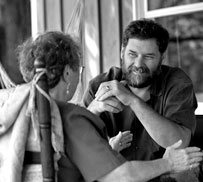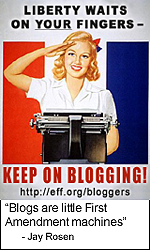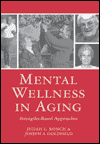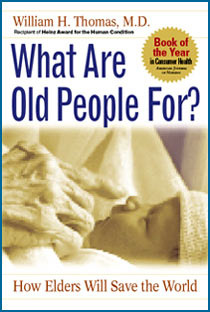![]()
Search
Recent Posts
- ChangingAging.org Redesign -- Please Bookmark!
- Disaster in Buffalo
- Power Up Friday
- Blanchard WinsDays
- Kevin Frick writes...
- Monkhouse Monday
- Getting Closer!
- Blanchard WinsDays
- Power Up Friday
- My Pick for Health and Human Services
- Understanding Health Care Reform
- Facts Are Stubborn Things: Social Security Edition
- Monkhouse Monday
- Localism is Coming
- Krugman Can't Wait...
Recent Comments
Category Archives
- AGING 100
- Aging
- Culture
- Dementia
- Eden Alternative
- Erickson School
- Green House
- Health Policy
- Longevity
- Media
- Rockets
Monthly Archives
- February 2009
- January 2009
- December 2008
- November 2008
- October 2008
- September 2008
- August 2008
- July 2008
- June 2008
- May 2008
- April 2008
- March 2008
- February 2008
- January 2008
- December 2007
- November 2007
- October 2007
- September 2007
- August 2007
 Subscribe to this blog's feed
Subscribe to this blog's feed
Announcements

Blog Data
« Red Beer... an Acquired Taste? | Main | Preventing the Epidemic of Falls »
January 27, 2008 |Permalink |Comments (0)
Must Watch, Must Share, Must Act Now
The Daily Kos today features a story on Annie Leanard's The Story of Stuff, a 20-minute online video that is, as Daily Kos puts it, "as direct, effective, and eye-opening on consumer society as An Inconvenient Truth is on climate change." 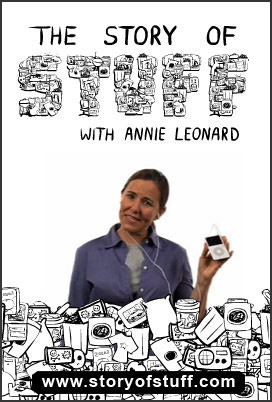 If you haven't seen it, stop reading and click on this image. NOW. Seriously. Go watch it.
If you haven't seen it, stop reading and click on this image. NOW. Seriously. Go watch it.
And here's the story behind The Story of Stuff.
Annie Leonard's The Story of Stuff by DevilstowerFor a year, Annie Leonard was part of a varied group of activists who met to polish their leadership skills. Month after month, despite her best efforts, she could tell that she wasn't getting through to the other participants. Five minutes into her talk on "changing the paradigm of our materials relationship," eyes were glazing over. It was Eli Pariser of moveon.org who finally gave her the insight she needed. "I have no idea what you just said," he told her. "I work on democracy, and all I know is that democracy doesn't have anything to do with 'materials.'"
But Annie knew that democracy had everything to do with materials. At the next meeting, she was back with a set of simple drawings on posterboard, and she was back with a new phrase. Instead of materials, she was there to talk about "stuff" -- all the stuff we eat, wear, use, throw out, burn, and bury. Instead of documenting the flow of resources through consumer society, she was telling The Story of Stuff.
With the help of producer Louis Fox and artist Ruben DeLuna at Free Range Studios, Annie turned her one hour talk into a twenty minute film. A film that's been watched by more than one million unique viewers. A film that's available on line and which you can watch by clicking the picture above. If you haven't seen the film go now. Seriously. Right now. You'll be glad you did. Because this short film is as direct, effective, and eye-opening on consumer society as An Inconvenient Truth is on climate change.
Though the original presentation was aimed at exciting activists, the short film is snappy enough to catch the attention of people who've never involved themselves in progressive causes. In the same day, Annie has received fan mail from American fourth graders and from Oxford dons. The simple graphics and enthusiastic narration of the film allow everyone to find themselves among the stick figures on screen. The appeal is so universal that the most frequent request Annie receives is to translate the Story of Stuff into other languages. At last count, there were more than 200 such requests, along with a book version in the works.
While Annie is thrilled at the attention The Story of Stuff has received so far, getting people to watch the film is just a small step toward a goal that may be tougher than landing a man on the moon: breaking the grip of the shop/consume/dispose culture and replacing it with a system that's sustainable.
While the problems of consumer culture have spread worldwide, America holds a unique place in the scheme that Annie dates back to decisions that we made at the outset of the Industrial Revolution. In some countries, people chose to take advantage of increasing productivity to reduce the work week, to take more vacations, and enjoy more time with family and friends. But in America, every gain was turned into a material gain, into more stuff. Rather than gathering in more happiness and freedom from advancing technology, we buried ourselves in an ever accelerating quest for the latest goodies. Generation by generation, year by year, we've accumulated more goods and consumed more of the world's resources (and made ourselves more miserable).
It's a problem that's perpetuated today by everything from the way we're entertained to the way we're educated. Where once we practiced "keeping up with the Joneses" by comparing ourselves to our neighbors, television has provided a window on consumer paradise where part-time baristas own huge Manhattan apartments and office workers dress in the latest designer duds. We're no longer happy to compare our possessions with the couple down the street, we have to compete with Brad and Angelina. We don't want what our friends have, or what our parents had, we want what Oprah has. This "vertical expansion of the reference group" means we can never reach our goals and are always left feeling as if we've failed. The only solution to our inadequacy? Go shopping for more stuff!
Shopping has become the key to how we view ourselves to such an extent that not only did George W. Bush urge us to shop ourselves out of the peril of 9/11, even environmental activists often turn to the mall. What's the most frequent advice dispensed to people trying to behave more responsibly? Buy green. It's advice that not only encourages still more consumption as means to address the problem of over-consumption, but it all too often ignores the market forces that have delivered "green" products to the local mall -- forces that rarely have any concern for the resources or people damaged along the way.
As we worry about the current economic downturn, even the way we attempt to measure our problems reflects this distorted shopaholic culture. Take a primal forest, kick out the people who have lived there for generations, cut down the trees, slice them into pieces, soak them in toxic chemicals, turn them into disposable products, and ship the discarded remains off to a landfill. On the business page of your local paper or the glitzy stock channel on your television, each of those steps has the same name: growth. What's a recession? Lack of growth. How do we end a recession? Stimulate spending on more disposable items, so we can buy more disposable goods, so we can cut down more forests, so we can have more... growth.
But if the first part of Annie's film is devoted to describing the problems of our current unsustainable culture of disposable goods, it's the final part that deserves special attention. Rather than stopping with the bad news, Annie shoots straight on into the good -- we can change. The most engaging part of her description of our society is that everyone can find their place in the flow, and the same dynamic means that everyone is positioned to help change how things work. Environmental issues, social justice, and economics all play into making the change toward a fair, sustainable society. There are as many ways to insert yourself into the process as there are products on the shelves of the local big box store.
In addition to translating the current film and giving her presentation, Annie has a second film in mind. This one focuses on the "green arrow," that arrow that's part of the virtuous cycle at the end of the film. That's where we all have to go if we're going to protect the remaining resources of our limited planet. Getting there is going to take courage that that few -- if any -- of our current candidates have shown.
But if any of them are serious about change, they could start with spending twenty minutes watching The Story of Stuff.
Thanks to Judith Shapiro for first cluing me into The Story of Stuff a couple months back.


